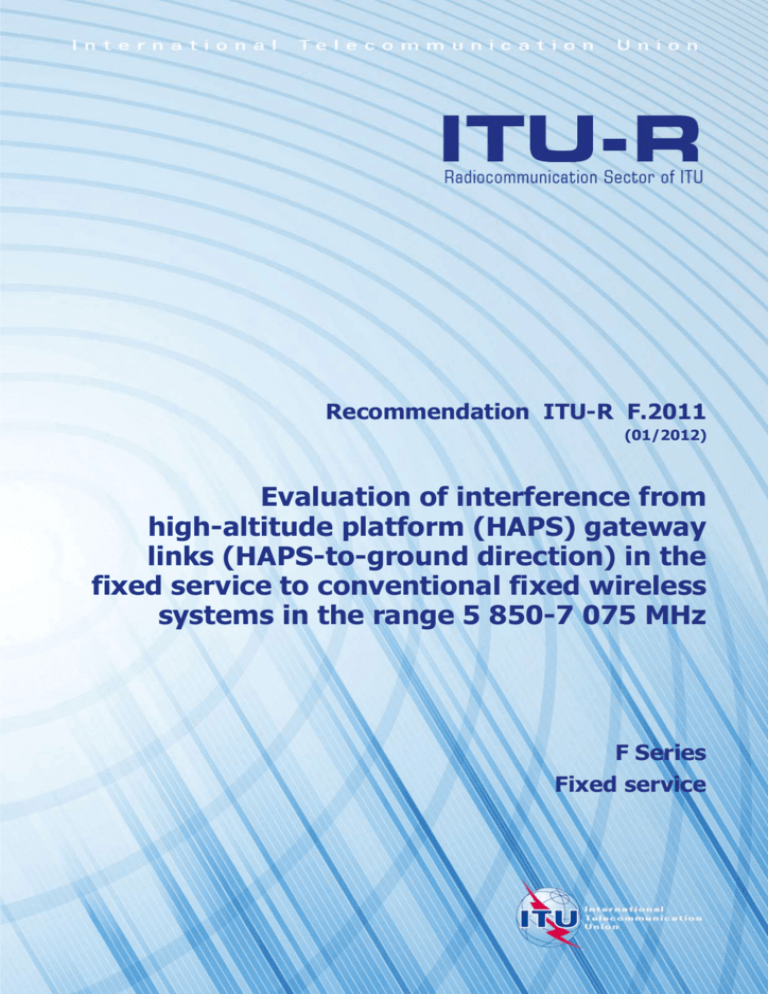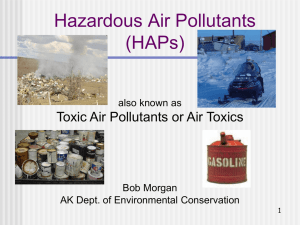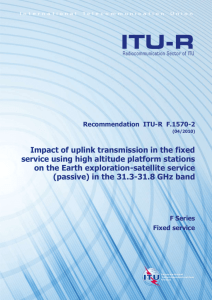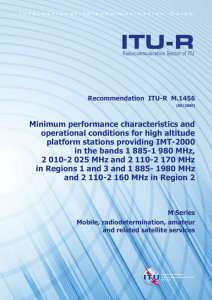
Recommendation ITU-R F.2011
(01/2012)
Evaluation of interference from
high-altitude platform (HAPS) gateway
links (HAPS-to-ground direction) in the
fixed service to conventional fixed wireless
systems in the range 5 850-7 075 MHz
F Series
Fixed service
ii
Rec. ITU-R F.2011
Foreword
The role of the Radiocommunication Sector is to ensure the rational, equitable, efficient and economical use of the
radio-frequency spectrum by all radiocommunication services, including satellite services, and carry out studies without
limit of frequency range on the basis of which Recommendations are adopted.
The regulatory and policy functions of the Radiocommunication Sector are performed by World and Regional
Radiocommunication Conferences and Radiocommunication Assemblies supported by Study Groups.
Policy on Intellectual Property Right (IPR)
ITU-R policy on IPR is described in the Common Patent Policy for ITU-T/ITU-R/ISO/IEC referenced in Annex 1 of
Resolution ITU-R 1. Forms to be used for the submission of patent statements and licensing declarations by patent
holders are available from http://www.itu.int/ITU-R/go/patents/en where the Guidelines for Implementation of the
Common Patent Policy for ITU-T/ITU-R/ISO/IEC and the ITU-R patent information database can also be found.
Series of ITU-R Recommendations
(Also available online at http://www.itu.int/publ/R-REC/en)
Series
BO
BR
BS
BT
F
M
P
RA
RS
S
SA
SF
SM
SNG
TF
V
Title
Satellite delivery
Recording for production, archival and play-out; film for television
Broadcasting service (sound)
Broadcasting service (television)
Fixed service
Mobile, radiodetermination, amateur and related satellite services
Radiowave propagation
Radio astronomy
Remote sensing systems
Fixed-satellite service
Space applications and meteorology
Frequency sharing and coordination between fixed-satellite and fixed service systems
Spectrum management
Satellite news gathering
Time signals and frequency standards emissions
Vocabulary and related subjects
Note: This ITU-R Recommendation was approved in English under the procedure detailed in Resolution ITU-R 1.
Electronic Publication
Geneva, 2012
ITU 2012
All rights reserved. No part of this publication may be reproduced, by any means whatsoever, without written permission of ITU.
Rec. ITU-R F.2011
1
RECOMMENDATION ITU-R F.2011*
Evaluation of interference from high-altitude platform (HAPS) gateway links
(HAPS-to-ground direction) in the fixed service to conventional fixed
wireless systems in the range 5 850-7 075 MHz
(2012)
Scope
This Recommendation provides a method for the evaluation of interference between fixed service
(FS) systems using high-altitude platform stations (HAPS) gateway links (HAPS-to-ground) and
conventional fixed wireless systems in the range 5 850-7 075 MHz in response to the technical
study invited by Resolution 734 (Rev.WRC-07). The method is used to determine areas where
specific values of I/N would be exceeded in an FS receiver. Results include plots and calculations
of the areas for various specified I/N values.
The ITU Radiocommunication Assembly,
considering
a)
that new technology utilizing high-altitude platform stations (HAPS) in the stratosphere has
been developed to provide high-capacity services;
b)
that some administrations intend to operate the systems using HAPS in the bands allocated
for such use by the Table of Frequency Allocations or by footnotes for the fixed service;
c)
that in addition to such service links, there is a requirement for gateway links which can
connect the service links to the public switched telephone network (PSTN), broadband data
networks, cellular telephone systems and sound and television broadcasting providers;
d)
that WRC-07 adopted Resolution 734 (Rev.WRC-07) requesting ITU-R sharing studies
with a view to identifying two channels of 80 MHz each for gateway links for HAPS in the range
from 5 850 to 7 075 MHz, in bands already allocated to the fixed service, while ensuring the
protection of existing services;
e)
that large portions of this band are heavily used by existing services,
recommends
that, in response to the technical study stated in considering d), to evaluate interference from HAPS
gateway links (HAPS-to-ground) in the fixed service to conventional fixed wireless systems in the
range 5 850-7 075 MHz the methodology described in Annex 1 should be used.
*
This Recommendation has been prepared in support of World Radiocommunication Conference 2012
(WRC-12) Agenda item 1.20. In the event that WRC-12 does not identify spectrum for gateway links for
high-altitude platform stations in this band, the Recommendation will be suppressed.
2
Rec. ITU-R F.2011
Annex 1
Evaluation of interference from high-altitude platform gateway links
(HAPS-to-ground direction) in the fixed service to conventional
fixed wireless systems in the range 5 850-7 075 MHz
1
Introduction
This Annex presents a methodology for determining the ratio of interference power to noise power
at the input of a point-to-point receiver in the fixed service due to operation of HAPS gateway
downlinks. This is one of the interference cases that should be considered under WRC-12 Agenda
item 1.20. The parameters and models used in the analysis are described in Section 2; the possible
I/N criteria that might be applied are described in Section 3; the methodology is described, applied
and the results obtained with it are presented in Section 4 for the case where the HAPS platform is
transmitting to only one gateway station. In Section 5, consideration is given to the aggregate
interference when the HAPS platform is transmitting to multiple gateway ground stations in
a symmetrical configuration. In Section 6, considerations are given to the effect of other parameters
on the results obtained. The focus of the studies in this document is on the band 5 925-6 875 MHz,
because this band is heavily used by the FS.
2
System description and parameters
The HAPS system under consideration in this study provides communication to five gateway
stations. Figure 1, which is taken from Recommendation ITU-R F.1891, shows the geometric
configuration of the system. The characteristics of the signals transmitted by the HAPS platform
transmitter are the ones given in Recommendation ITU-R F.1891. They are summarized in Table 1.
FIGURE 1
Example of HAPS gateway station configuration and
internal HAPS network interference
HAPS
21 km
Not to scale. Look angles
are considerably distorted.
i ng
rfer
In te
2
W
an
ted
s
ig
na
l
3
n
si g
w
s ig n
al
f
UAC zone
b
al
1
Nadir
36 km
radius
a
5
Int
erfe
ri n
g
q
4
HAPS-GS
F.5-1006-01
Rec. ITU-R F.2011
3
TABLE 1
Characterization of the HAPS platform transmitter
Parameter
Symbol
Value
Frequency (GHz)
6.5
Transmit power (dBW)
−22
Bandwidth (MHz)
11
Transmit power density (dBW/MHz)
−32.4
Pt
Transmit feeder loss (dB)
4.1
Maximum antenna gain (dBi)
Gtmax
30
Main beam 3 dB beamwidth (degrees)
5.2
Reference antenna pattern bh degrees from
maximum (dBi)
Gh(bh)
Resolution 221
(Rev.WRC-07)
Ah
21.0
Height of HAPS platform (km)
The following HAPS antenna is considered in these analyses:
Resolution 221 (Rev.WRC-07) array antenna: This is the antenna pattern that appears in
Resolution 221 (Rev.WRC-07). It has a near side-lobe level of 25 dB below the main-beam gain of
30 dBi. The gain for angles more than 63° from the main-beam axis is −43 dBi as shown in Fig. 2.
No working model of an antenna conforming to this pattern has been manufactured or
demonstrated.
FIGURE 2
Gain pattern for Resolution 221, antenna having a maximum gain of 30 dBi
Resolution 221 reference antenna pattern
40
Antena gain (dBi) for 30 dBi antenna
20
0
–20
–40
–60
0
10
20
30
40
50
60
70
80
90
Angle (degrees)
F.5-1006-02
4
Rec. ITU-R F.2011
The characteristics assumed for the FS receiver are summarized in Table 2. These values are
consistent with values in Recommendation ITU-R F.758.
TABLE 2
FS parameters
Parameter
Symbol
Value
Frequency (GHz)
fGHz
6.5
Maximum antenna gain (dBi)
Grmax
45.0
Reference antenna pattern gain br degrees from
maximum (dBi)
Gr(br)
Recommendation
ITU-R F.699
Antenna height (km)
Af
0.060
Antenna elevation angle (degrees)
a
0.0
Feeder loss (dB)
Lf
3.0
Receiver noise temperature (Kelvins)
Teff
725
Reference bandwidth (MHz)
B
1.0
Receiver noise floor (dBW/MHz)
NT
−140.0
The interfering signal power at a fixed service receiver is determined by the following equation:
I r Pt Gh (bh ) Gr (br ) Lb L f
(1)
where all terms have been defined in Tables 1 and 2 except for Lb, the propagation loss.
The propagation loss is determined as:
Lb 92.4 20log( fGHz ) 20log( d km)
(2)
where dkm is the length of the propagation path in kilometres from the HAPS platform transmitter to
the FS receiving antenna.
The interference power is assumed to propagate on a straight line path within the plane of the great
circle determined from the positions of the HAPS transmitter, the FS receiver, and the centre of the
Earth where the Earth is assumed to have a radius (8 504 km) that is 4/3 of its actual value
(6 378 km). This allows the effect of atmospheric refraction to be taken into account. The I/N ratio
used in this study is the difference between the value of the interference power Ir of equation (1)
and the noise power NT given in Table 2 with both values given in dBW/MHz.
3
Interference criteria
Before discussing the simulation methodologies it is necessary to determine the appropriate
interference criteria to be applied in this sharing situation. The interference criteria used by the fixed
service is considered to be a matter for each administration to decide. In the Radio Regulations
HAPS is considered to be an application within the fixed service; however, it is not clear how
administrations would choose to treat it. For the purpose of discussion, a HAPS transmitting station
will be treated here as any other FS transmitting station.
Rec. ITU-R F.2011
5
At the present time there is no agreed value for acceptable interference from HAPS. On the
assumption that the HAPS system is entering into an environment heavily used by the FS and
already shared with the FSS, any new HAPS system, if permitted under RR No. 4.15A, should be
allowed to add to the interference noise only incrementally. Assuming a 20% allowance for the total
contribution of interference from all sources to the total noise, a value of 10% of this allowance
could be allocated to HAPS interference. This would result in an I/N criterion of about −17 dB for
HAPS systems.
Administrations may choose other allowances and allocations, but a range of I/N values between
−10 and −20 dB would appear to be of the greatest interest. This is the range that will receive the
greatest attention in the following developments. To cover all eventualities results have been
calculated for all I/N ratios between 0 and −20 dB.
4
Description and application of the I/N methodology
The I/N at an FS receiver, using the parameters specified in Tables 1 and 2, would depend on its
position in the layout of Fig. 1 and on the azimuth of the main beam axis of its antenna.
This section considers the case where the HAPS platform transmits to only a single gateway station
on the surface of the Earth. All geographic locations are specified by their great circle distance from
the point on the surface of the Earth that is directly below the HAPS platform. In HAPS
terminology, the point on the surface of the Earth directly below the HAPS platform is often
described as the HAPS nadir. In this Annex, it will be designated as the HAPS Sub-Platform Point
(SPP). The other coordinate needed to specify a geographic location is the azimuth angle of the
great circle path from the SPP to the point. This angle is measured at the HAPS SPP in a counterclockwise direction from the azimuth to the gateway station.
The method described in this section is to determine the locations where a given I/N level will be
exceeded for the two extreme pointing azimuths of the FS antenna at each location. One case is
where the azimuth of the FS receiving antenna is directed along the great circle toward the HAPS
SPP. The other is where the azimuth of the FS receiving antenna is directed 180° from the direction
toward the HAPS SPP. The areas where a given I/N ratio will be exceeded for the case where the FS
antenna is pointed toward SPP will be called a coordination area since a frequency coordination
process would be needed to determine whether that I/N would be exceeded for a particular receiver.
The geographical region, if any, where the I/N ratio would be exceeded for the case where the FS
antenna is pointed away from SPP will be called an exclusion zone because there is no pointing
angle for which the I/N ratio would not be exceeded. As used in this Annex, an exclusion zone is
specific to the model parameters and to the I/N value chosen for an interference criterion.
The radial extent of a coordination or exclusion zone is determined by stepping along a great circle
path from the HAPS SPP and determining at each step whether an edge of a particular I/N
geographical region has been encountered. The calculation numbers successive areas on each
azimuth where a threshold I/N ratio is exceeded. All of the elemental areas with the same number
are considered to be part of the same composite geographical region.
Figure 3 shows the results of such a calculation for an I/N threshold of −20 dB using the HAPS
array antenna transmitting to a gateway station that is 36 km from the SPP and using the parameters
from Tables 1 and 2. (The characteristic values of Tables 1 and 2 are used for all subsequent
calculations unless otherwise noted.) The I/N threshold of −20 dB was chosen for Fig. 3 and the
following figures to illustrate cases where exclusion zones exist. For this case, the coordination area
is identified with the dotted line and the exclusion zone with the solid line. These areas surround the
location of the gateway station and, therefore, must result from the coupling of the main-beam gain
of the HAPS array to the side lobes of the FS antenna. Because the gain pattern of the HAPS array
6
Rec. ITU-R F.2011
antenna rolls off so rapidly with the angle from main-beam axis, there is no area due to the HAPS
side lobes coupling energy to the main lobe of an FS receiving antenna for this case.
Rather than provide plots for other I/N ratios, Table 3 summarizes the results for various I/N
thresholds by tabulating the areas of the coordination area and exclusion zone for each I/N. For this
example all of the entries in the Area 2 column are zero, which means that there is only one
coordination area. The entries in the column for the area of Area 2 are zero and the entries for the
total coordination area are the same as those for Area 1.
Note that in cases where Area 2 is zero, Area 1 is a contiguous geographical region. Where Area 2
is not zero, the various components of Area 1 may not be contiguous. This result is discussed
further in Section 6 of this Annex.
When there is a geographical region near a gateway where the HAPS antenna main beam couples
sufficient energy into the FS antenna side lobes to exceed the I/N threshold, there may be
an exclusion zone. An exclusion zone will always be surrounded by a coordination area. For each
I/N value there can be no more than one exclusion zone per gateway station. Thus, for all cases
considered in this section there is only one exclusion zone.
From Table 3, the coordination area and exclusion zone decrease gradually with increasing I/N.
The exclusion zone disappears for an I/N threshold of −19 dB or greater and the coordination area
disappears for an I/N value of −14 dB or more.
FIGURE 3
Coordination and exclusion regions with array antenna
Gateway is 36 km from HAPS sub-platform point, I/N = −20 dB
3
Transverse axis (km)
2
1
0
–1
–2
–3
0
5
10
15
20
25
30
35
40
45
Axis toward gateway (km)
Coordination
Exclusion
Gateway
F.5-1006-03
Rec. ITU-R F.2011
7
TABLE 3
Areas of coordination and exclusion zones with array antenna
when gateway is 36 km from the SPP
5
I/N
Area 1
(km2)
Area 2
(km2)
Total area of
coordination
(km2)
Exclusion
zone (km2)
−20
50.4
0
50.4
6.6
−19
40.2
0
40.2
0
−18
32.9
0
32.9
0
−17
24.3
0
24.3
0
−16
16
0
16
0
−15
6.9
0
6.9
0
−14
0
0
0
0
Aggregate interference from HAPS platforms to FS point-to-point receivers
This section considers the effect of HAPS platform transmitters operating to multiple gateway
stations. Figure 4 shows the coordination areas and exclusion zones for an I/N of −20 dB in the case
where there are five gateway stations equally spaced at a distance of 36 km from the HAPS nadir.
Table 4 shows the areas of the coordination and exclusion zones for this case. It is clear that
because of the low gain of this antenna in the far side-lobe sectors there are no new areas caused by
the aggregation of the power transmitted to the five gateway ground stations. This is clearly the case
for an I/N of −20 dB and, therefore, will be the case for all more positive I/N values. This result is
due to the rapid fall-off of antenna gain with increasing off-axis angle that is the characteristic of
the Resolution 221 (Rev.WRC-07) array antenna.
Each of the individual coordination areas and exclusion zones in Fig. 4 is virtually identical to the
same areas in Fig. 3. These areas in Table 4 are just five times the values given in Table 3.
8
Rec. ITU-R F.2011
FIGURE 4
Coordination and exclusion regions for array antennas
with five and
gateway
stations,
I/N =for−20
dB antennas
Coordination
exclusion
regions
array
with 5 gateway stations, I/N = –20 dB
50
Transverse axis (km)
25
0
–25
–50
–75
–50
–25
0
25
50
75
Axis toward one gateway (km)
Coordination
Station
Exclusion
F.5-1006-04
TABLE 4
Areas of coordination and exclusion zones for array antennas
with five gateways 36 km from the SPP
6
I/N
Area 1
(km2)
Area 2
(km2)
Total area
of
coordination
(km2)
Exclusion
zone (km2)
−20
251.8
0
251.8
33.2
−19
201.1
0
201.1
0
−18
163.8
0
163.8
0
−17
120.8
0
120.8
0
−16
80.1
0
80.1
0
−15
34.7
0
34.7
0
−14
0
0
0
0
Consideration of FS elevation angle and gateway distance from SPP
In all of the previous examples, the elevation angle of the FS antenna has been considered to be
0 degrees. Elevation angles of up to 5 degrees have no effect on the areas of the coordination areas
and exclusion zones for the Resolution 221 array antenna. They remain as shown in Figs. 3 and 4
and in Tables 3 and 4. The cases where the use of this antenna could produce additional areas where
Rec. ITU-R F.2011
9
the interference into a FS receiver would exceed a threshold value are those involving either large
FS elevation angles, or increased distances for the gateway station in addition to non-zero FS
elevation angles. Figure 5 shows the coordination areas and exclusion zones that would be obtained
for an elevation angle of 3 degrees if a single gateway were 76 km from the HAPS SPP. Such an
operation would require an increase in transmit power in order to maintain the link margin.
To facilitate discussions it is useful to designate the areas where I/N exceeds a threshold value
because of coupling between the main lobe (ML) of the HAPS antenna and the side lobes (SL)
of the FS antenna as ML-SL areas and the areas where I/N exceeds a threshold value because of
coupling between the side lobes of the HAPS antenna and the main lobe of the FS antenna as
SL-ML areas. The ML-SL geographical region is only identifiable as Area 1 at azimuth angles
about the SPP where Area 2 is not present (has no area).
There are several important characteristics of SL-ML areas. One is that they tend to be very large
when they do exist as may be seen from the total areas for coordination areas in Table 5. Another is
that SL-ML areas occur at distances from the HAPS SPP that are beyond the distance to the
gateway, possibly out to the limits of line-of-sight visibility. At azimuths from the HAPS SPP that
pass close to the gateway there will be I/N ratios for which both Area 1 and Area 2 are encountered.
Thus, only the portion of the larger geographical region in Fig. 5 that is blocked by the ML-SL
geographical region will appear in Area 2. The remainder of the area of the larger geographical
region will be aggregated with the area of the ML-SL geographical region in Area 1.
The input parameters used in generating Fig. 5 and Table 5 do not produce an extremely large
SL-ML coordination area. However, the coordination area that they produce does not disappear
until the I/N threshold is −2 dB or greater.
FIGURE 5
Coordination and exclusion regions for array antennas with gateway 76 km
from nadir, Pt = –26.4 dBW/MHz, Gtmax = 30 dBi,
FS antenna elevation angle = 3 degrees, I/N = −20 dB
10
Rec. ITU-R F.2011
TABLE 5
Areas of coordination and exclusion zones for an array antenna with
a single gateway station 76 km from the SPP, Pt = −24.4 dBW/MHz,
Gtmax = 34 dBi, and FS antenna elevation angle of 3 degrees
I/N
Area 1
(km2)
Area 2
(km2)
Total area
of
coordination
(km2)
Exclusion
zone (km2)
−20
9 931.6
12 256
22 187.7
63.1
−19
8 593.9
11 572.6
20 166.6
23.6
−18
8 539.7
8 527.3
18 226.3
0
−17
8 544.9
6 685.9
16 387.3
0
−16
7 475.1
6 038.6
14 661.8
0
−15
6 454.2
2 532.3
13 027.4
0
−14
5 475.5
5 879.1
11 354.6
0
−13
5 445.1
4 640.2
10 085.3
0
−12
4 614.8
4 376.5
8 991.3
0
−11
3 804
4 100.1
7 904.1
0
−10
3 007
3 809.5
6 816.5
0
−9
2 963.3
2 791.6
5 754.8
0
−8
2 203.8
2 535
4 738.8
0
−7
2 074.4
1 655.8
3 730.2
0
−6
1 367.8
1 437.1
2 804.9
0
−5
1 169.2
733.4
1 902.6
0
−4
881.3
187.9
1 069.2
0
−3
255.7
0
255.7
0
−2
0
0
0
0
_______________






![Recommendation ITU-R F.[HAPS CHAR] “Technical and](http://s3.studylib.net/store/data/007072239_1-9e2173f88c434fa75c3e066f11f91405-300x300.png)
